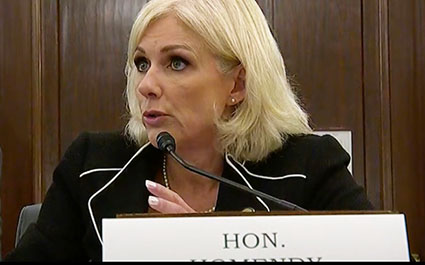by WorldTribune Staff, March 8, 2024
National Transportation Safety Board (NTSB) Chair Jennifer Homendy said during a March 6 hearing of the Senate Committee on Commerce, Science, and Transportation that the controlled burn of five rail cars on Feb. 6, 2023 at the train derailment site in East Palestine, Ohio was “unnecessary.”
The controlled burn unleashed a highly toxic, catastrophic cloud of vinyl chloride, causing the governors of Ohio and Pennsylvania to order an evacuation of a 1- by 2-mile area that crossed the state line and spread to surrounding states.

Under questioning from Ohio Republican Sen. JD Vance, Homendy said the results of the NTSB investigation show contractors associated with Norfolk Southern may have been responsible for the decision to initiate the controlled burn, UncoverDC reported on Friday.
At the time of the derailment, Ohio officials asserted the controlled burn was necessary, and its fallout would be mitigated due to favorable weather conditions. Reportedly, there was very little wind that day. However, Homendy’s testimony revealed the burn was “entirely unnecessary” for various reasons.
The temperature readings monitored by Norfolk Southern on Feb. 5 and 6 were declining and then stabilized “many hours before the vent and burn was initiated,” according to Homendy. Declining or stabilized temperatures are factors that inform decisions as to whether a controlled (vent and burn) will be necessary.
The second, according to Homendy, is polymerization. According to Homendy, polymerization was not occurring at the time. She told the committee that to justify a controlled burn, “you would have to have rapidly increasing temperatures and some sort of infusion of oxygen, neither of which occurred.” Homendy confirmed both are needed to create the uncontrolled conditions that precipitate polymerization. Polymerization creates a situation whereby the reaction of the molecules becomes exothermic or creates energy released by the reaction. Vinyl chloride is a volatile, flammable chemical.
In addition, Homendy said Norfolk Southern’s contractors were not even sure at the time that a chemical reaction was occurring in the vinyl chloride tank car. Moreover, OxyChem experts were on site advising Norfolk Southern contractors at the time. Yet somehow, Norfolk Southern ignored their expert advice. Homendy explained Norfolk Southern contractors “lacked the scientific background” to address the issues at hand and “disregarded available temperature data” from Oxy Vinyl. Vance summarized the back-and-forth discussion as follows:
“We combine all these facts together. Your reporting thus far concludes that Norfolk Southern contractors’ recommendation to conduct a controlled burn lacks sufficient scientific basis, disregarded available temperature data, and contradicted expert feedback from the shipping firm on site. Now, this was all told to the decision makers on the ground that they had to make a decision in less than 13 minutes—to blow up all five of these toxic chemical cars without any other voices being included to offer a contrary opinion, is that right?”
Homendy confirmed Vance’s summary of the data and also made a point of adding:
“May I add something to that, Senator? I would say the factual information in our docket shows that Oxy Vinyls was on scene and providing information to Norfolk Southern and their contractors on the 4th, 5th, and 6th. They believed polymerization was not occurring, and there was no justification to do a vent and burn. But there was another option. Let it cool down. It was cooling down. We know for a fact that when that pressure relief device went off, that it had to have been above 185°. Later, much later, over the course of 22 hours, that tank car was cooling. Not to mention the other four tank cars that were only between 64 and 69°. So Oxy Vinyls was on scene providing [that] information to Norfolk Southern contractors.”
Homendy also pointedly stated that neither the incident commander nor the Ohio governor was given complete information when briefed. She shared that Oxy Vinyls was not even in the room. In fact, the governor apparently never even knew they existed. Because of their absence at the meeting, Governor DeWine and the incident commander “lacked the information they needed to make a decision.” Homendy reserved her criticism for the “people on the ground” who provided inaccurate and inadequate information to the governor.
The troubling circumstances that led to the controlled burn prompted Vance to speculate about the reasons for the rushed and unscientific decisions: “This is a really, really troubling set of circumstances in this town…a town that may have been poisoned to facilitate the rapid movement” of trains on the track. Vance explained that East Palestine residents had “talked about the fact about the fact that immediately after the uncontrolled burn, they moved the tank cars, and train traffic was then moving through their town and community” in short order.
Quality Resource for Citizen Journalists
